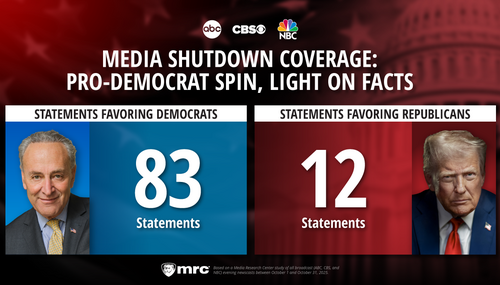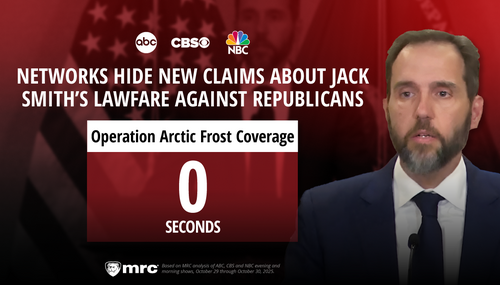A new, New Deal may very well be on its way, but one of FDR’s own New Deal creations, the Tennessee Valley Authority (TVA), is in big trouble.
Federally-owned TVA, the nation’s largest utility, recently made headlines for spilling more than a billion gallons of “thick black” coal sludge that literally “swallowed” up homes as it spread out over hundreds of acres in eastern Tennessee. It destroyed three homes and damaged dozens, forcing evacuations just days before Christmas 2008.
NBC “Nightly News” called the “toxic mess” “30 times larger than the 1989 Exxon-Valdez disaster,” on Dec. 24.
But news coverage on the three broadcast networks and three major newspapers barely mentioned that the TVA is under federal ownership – making this environmental tragedy the government’s fault and the taxpayers’ liability. Since Dec. 24, only 2 out of 18 (11 percent) newspaper reports in The New York Times, Washington Post and Los Angeles Times admitted that fact. The ratio was slightly higher for the networks with 2 admissions out of 15 broadcast stories on ABC, CBS and NBC(13 percent).
NBC “Nightly News” spoke to James Sheen, who was asleep when the river of sludge hit his home. “I climbed out the window and – before the house completely – completely collapsed,” Sheen told NBC Dec. 24.
“Hundreds of millions of gallons of coal ash mixed with water, enough to fill more than 550 Olympic-sized swimming pools, broke through an earthen dam in the town of
“The ash came within yards of the home of Deanna Copeland, a customer service worker, and enveloped her dock, she said. Pieces of her neighbor’s house were in her yard. ‘To see this happen on the week of Christmas, it’s devastating,’ Ms. Copeland said. ‘People are pretty upset. The big question now is, What’s T.V.A. going to do to fix things?’” The New York Times wrote on Dec. 24.
They’re probably going to pay a lot of money in court. Two
Despite the government’s culpability, most of the news reports portrayed the disaster as a failure of the coal industry. They included left-wing environmentalists’ attacks on coal and calls for more regulation of the utility industry, instead of blaming the government for failing to police itself.
Coal, Not Government, Gets a Black Eye
The only rightful target for blame was the TVA itself which allowed the spill to happen, and the bureaucracy that failed to govern the government utility.
According to
TVA’s CEO Tom Kilgore admitted to the Senate Environment and Public Works Committee that “the most expensive solution wasn’t chosen … Obviously, that doesn’t look good for us.” That solution would have cost the TVA $25 million – only $5 million more than the current estimate for cleaning up the mess and nowhere near as much as lawsuits might cost.
At least one government figure took some blame for the disaster. Sen. Barbara Boxer, D.-Calif., accepted responsibility for not properly overseeing TVA saying “We didn’t really do much in the first two years looking at T.V.A.,” according to the Jan. 9 New York Times.
But a
“Where’s the outrage? Where are the special hearings and calls for resignations?” Mitchell asked.
There certainly wasn’t outrage against government on the networks. Much like the 2008 coverage of another FDR creation, Fannie Mae, broadcast journalists criticized industry and called for more government intrusion rather than pointing out the failure of government.
In fact, one-third of the broadcast stories presented environmentalists’ attacks on the entire coal industry – as if a private industry had anything to do with the
NBC “Nightly News” quoted a Union of Concerned Scientists spokesman condemning the “oxymoron” of clean coal on Dec. 24. CBS’s Mark Strassman said “the industry touts its cleaner product,” but turned to the same UCS critic for a rebuttal.
NBC even asserted Dec. 27 that the TVA spill was giving “the coal industry’s clean coal campaign a black eye.” But the spill should have given a black eye to the concept of government-run businesses.
“[E]nvironmentalists are trying to use this coal ash spill as an example to illustrate what they’ve been saying all along,” ABC’s Gigi Stone said in a Dec. 27 report before quoting Stephen Smith of the Southern Alliance for Clean Energy.
Smith said, “To call this clean coal is absolutely ridiculous. This is devastating.” Stone followed Smith’s remarks by mentioning a coal industry campaign “to present itself, not as a global pollutant, but as a clean energy alternative if the proper technology is developed.”
The New York Times argued Jan. 7 that regulation could have prevented the problem, but was lacking because the EPA “backpedaled in the face of an industry campaign.”
TVA: Fact and Fiction
There’s a country song by
Well, somebody told us Wall Street fell
But we were so poor that we couldn’t tell.
Cotton was short and the weeds were tall.
But Mr. Roosevelt’s a gonna save us all.
Well, momma got sick and daddy got down.
The county got the farm and they moved to town.
Pappa got a job with the TVA
He bought a washing machine and then a Chevrolet.
But that mythic idea of the TVA bringing rural Tennesseans out of poverty isn’t the whole story.
As William Chandler wrote in his book, The Myth of TVA, despite the folklore surrounding the New Deal experiment, incomes grew as fast or faster in neighboring non-TVA areas, and manufacturing, electrification and running water installation all progressed more slowly under the TVA than in those places.
According to reports by NEMW, the government corporation has been in desperate need of reform for years.
In 2003, NEMW warned that TVA had accumulated billions of dollars in debt, was the “the nation’s worst violator of the Clean Air Act, and was virtually unaccountable. “Their decisions are not reviewed by state regulators or federal agencies,” wrote Dick Munson, then Director of NEMW. The TVA’s monopoly power also prevents them from being held accountable to market forces.
Two years earlier, in 2001, Munson wrote that “TVA is literally above the law. It is exempt from at least 137 federal statutes, ranging from workplace safety to hydroelectric licensing.”
TVA’s 1999 annual report explained who regulates its actions: “a Board of presidential appointees who are charged first and foremost with serving the public interest.”





